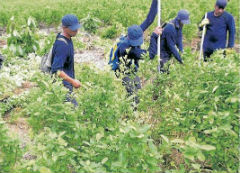Colombia’s government will be launching an experimental program — developed during peace talks with the FARC guerrillas — for reducing coca crops in the conflict-ridden municipality of Tumaco. However, it is still unclear how the program will avoid the missteps of past coca eradication strategies.
On March 16, the government announced it had chosen the southwestern municipality of Tumaco as one of the first targets for its new anti-coca strategy. In a statement, President Juan Manuel Santos said that conditions in Nariño department, where Tumaco is located, are ideal for testing these new coca control schemes, before rolling them out across the country.
The anti-coca strategy, based on the agreement made during peace talks between the government and the guerrillas of the Revolutionary Armed Forces of Colombia (FARC), is meant to help farmers move away from coca crops by offering them legal alternatives such as cacao, rubber, and coffee.
President Juan Manuel Santos pledged the scheme would be implemented in coordination with locals.
“We are going to put the plan into practice with the help of communities, mayors, local government and above all the farmers,” he said.
Minister of Defense Luis Carlos Villegas promised farmers “long-term technical assistance” and “the most advanced technological packages” to aid their the transition into the legal economy.
Villegas also announced that 5,000 members of the armed forces would assist the government’s official coca eradication teams. One of their top priorities will be eliminating coca in seven of Colombia’s national parks.
InSight Crime Analysis
Selecting Tumaco as the pilot experiment for Colombia’s new coca policy makes sense. According to the latest United Nations Office on Drugs and Crime (UNODC) coca study (pdf), Nariño department, where Tumaco is based, produces 25 percent of Colombia’s coca crop and saw a 31 percent leap in production in 2014.
The UN also identified Nariño and other southern states as Colombia’s biggest challenge in tackling coca cultivation not only because of the number of coca crops found here, but also because many conflict-ridden communities are reluctant to trust the state.
SEE ALSO: The FARC, Peace and Possible Criminalization
However, details remains scarce on how this pilot program will address the problems that have plagued previous attempts at coca substitution. These have been stymied by poor top-down planning and a lack of complementary investment in local infrastructure, particularly the transport networks required to take legal crops to market.
The agreement made between the FARC and the government promised to address these issues through improved coordination with local communities over substitution programs and more investment in rural infrastructure. However, details on how this will play out in practice remain conspicuously absent from the government’s declarations.

